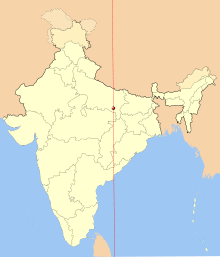| Indian Standard Time | |
|---|---|
| Time zone | |
 Indian Standard Time | |
| UTC offset | |
| IST | UTC+05:30 |
| Current time | |
| 05:35, 4 July 2024 IST [refresh] | |
| Observance of DST | |
| DST is not observed in this time zone. | |
Indian Standard Time (IST), sometimes also called India Standard Time, is the time zone observed throughout the Republic of India, with a time offset of UTC+05:30. India does not observe daylight saving time or other seasonal adjustments. In military and aviation time, IST is designated E* ("Echo-Star").[1] It is indicated as Asia/Kolkata in the IANA time zone database.
|
Main article: Time in India |
The Indian Standard Time was adopted on 1 January 1906 during the British era with the phasing out of its precursor Madras Time (Railway Time),[2] and after Independence in 1947, the Union government established IST as the official time for the whole country, although Kolkata and Mumbai retained their own local time (known as Calcutta Time and Bombay Time) until 1948 and 1955, respectively.[3] The Central observatory was moved from Madras to a location at Shankargarh Fort in Allahabad district, so that it would be as close to UTC+05:30 as possible.[4]
Daylight Saving Time (DST) was used briefly during the China–India War of 1962 and the Indo-Pakistani Wars of 1965 and 1971.[5]
| Time Zone | UTC | Period | Purpose |
|---|---|---|---|
| Bombay Time | UTC+04:51 | 1884–1955 | Official |
| Calcutta Time | UTC+05:53:20 | 1884–1948 | Official |
| Madras Time | UTC+05:21:14 | 1802–1906 | Railways |
| Port Blair mean time | UTC+06:10:37 | 19th century–1906 | Local |

Indian Standard Time is calculated from the reference longitude of IST at 82°30'E passing near Mirzapur.[6] In 1905, the meridian passing east of Allahabad was declared as a standard time zone for British India and was declared as IST in 1947 for the Dominion of India.[7] This longitude of 82°30'E was chosen as the standard meridian for the whole country[8] as it is located centrally between western India (local time UTC +05:00) and northeastern India (local time UTC +06:00). Currently, the Council of Scientific and Industrial Research- National Physical Laboratory (CSIR-NPL) maintains the Indian Standard Time with the help of the Allahabad Observatory.[9]
The country's east–west distance of more than 2,933 kilometres (1,822 mi) covers over 29° of longitude, resulting in the sun rising and setting almost two hours earlier on India's eastern border than in the Rann of Kutch in the far west. Inhabitants of the northeastern states have to advance their clocks with the early sunrise to avoid the extra consumption of energy after daylight hours.[6]
In the late 1980s, a team of researchers proposed separating the country into two or three time zones to conserve energy. The binary system that they suggested involved a return to British-era time zones, but the recommendations were not adopted.[6][10]
In 2001, the government established a four-member committee under the Ministry of Science and Technology to examine the need for multiple time zones and daylight saving.[6] The findings of the committee, which were presented to Parliament in 2004 by the Minister of Science and Technology, Kapil Sibal, did not recommend changes to the unified system, stating that 'the prime meridian was chosen with reference to a central station, and that the expanse of the Indian State was not large.'[11]
Though the government has consistently refused to split the country into multiple time zones, provisions in labour laws such as the Plantations Labour Act, 1951 allow the union and state governments to define and set the local time for a particular industrial area.[12] In Assam, tea gardens follow a separate time zone, known as the Chaibagan or Bagan time ('Tea Garden Time'), which is one hour ahead of IST.[13] Still, Indian Standard Time remains the only officially used time.
In 2014, Chief Minister of Assam Tarun Gogoi started campaigning for another time zone for Assam and other northeastern states of India.[14][15] However, the proposal would need to be cleared by the union government.
In June 2017, the Department of Science and Technology (DST) indicated that it is once again studying the feasibility of two time zones for India. Proposals for creating an additional Eastern India Time (EIT at UTC+06:00), shifting default IST to UTC+05:00 and daylight saving (Indian Daylight Time for IST and Eastern India Daylight Time for EIT) starting on 14 April (Ambedkar Jayanti) and ending on 2 October (Gandhi Jayanti) was submitted to DST for consideration.[16][needs update]
Official time signals are generated by the Time and Frequency Standards Laboratory at the National Physical Laboratory in New Delhi, for both commercial and official use. The signals are based on atomic clocks and synchronised with the worldwide system of clocks that support Coordinated Universal Time.
Features of the Time and Frequency Standards Laboratory include:
IST is taken as the standard time as it passes through almost the centre of India. To communicate the exact time to the people, the exact time is broadcast over the national All India Radio and Doordarshan television network. Telephone companies have dedicated phone numbers connected to mirror time servers that also relay the precise time. Another increasingly popular means of obtaining the time is through Global Positioning System (GPS) receivers.[17]